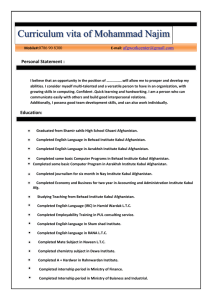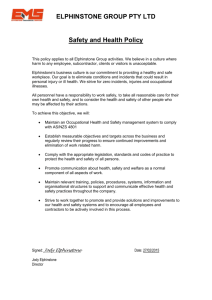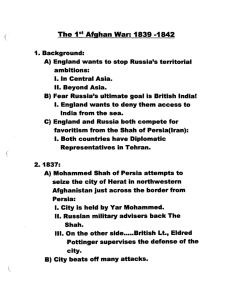Activity 8. Afghanistan Resists Occupation (1839 – 1979) Background:
advertisement
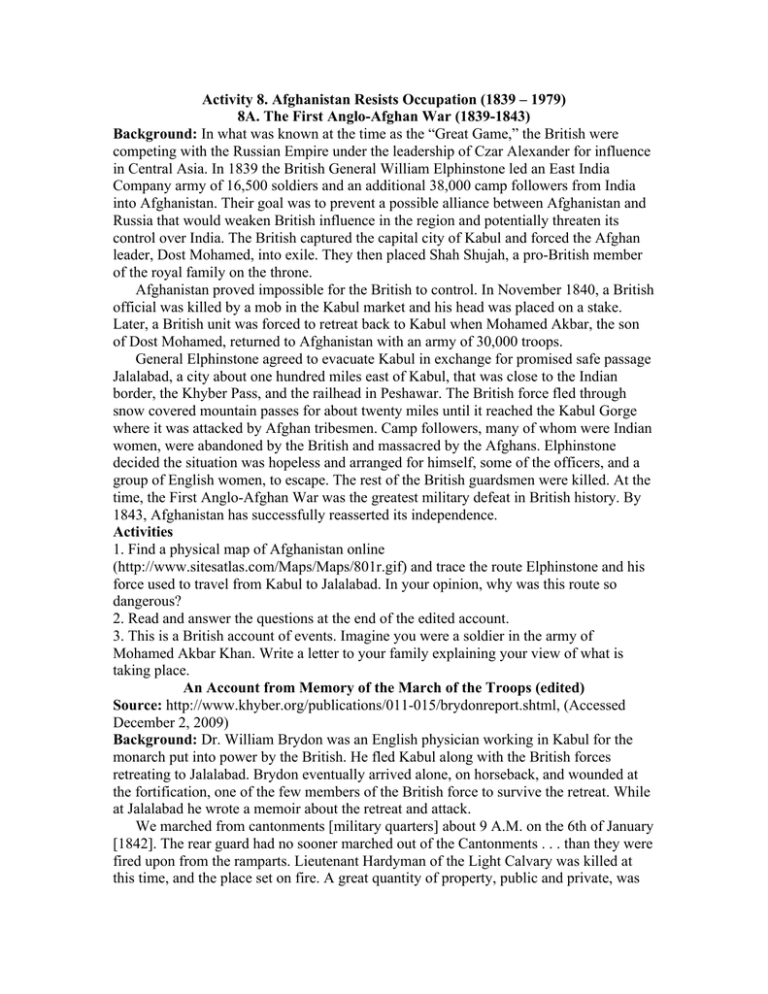
Activity 8. Afghanistan Resists Occupation (1839 – 1979) 8A. The First Anglo-Afghan War (1839-1843) Background: In what was known at the time as the “Great Game,” the British were competing with the Russian Empire under the leadership of Czar Alexander for influence in Central Asia. In 1839 the British General William Elphinstone led an East India Company army of 16,500 soldiers and an additional 38,000 camp followers from India into Afghanistan. Their goal was to prevent a possible alliance between Afghanistan and Russia that would weaken British influence in the region and potentially threaten its control over India. The British captured the capital city of Kabul and forced the Afghan leader, Dost Mohamed, into exile. They then placed Shah Shujah, a pro-British member of the royal family on the throne. Afghanistan proved impossible for the British to control. In November 1840, a British official was killed by a mob in the Kabul market and his head was placed on a stake. Later, a British unit was forced to retreat back to Kabul when Mohamed Akbar, the son of Dost Mohamed, returned to Afghanistan with an army of 30,000 troops. General Elphinstone agreed to evacuate Kabul in exchange for promised safe passage Jalalabad, a city about one hundred miles east of Kabul, that was close to the Indian border, the Khyber Pass, and the railhead in Peshawar. The British force fled through snow covered mountain passes for about twenty miles until it reached the Kabul Gorge where it was attacked by Afghan tribesmen. Camp followers, many of whom were Indian women, were abandoned by the British and massacred by the Afghans. Elphinstone decided the situation was hopeless and arranged for himself, some of the officers, and a group of English women, to escape. The rest of the British guardsmen were killed. At the time, the First Anglo-Afghan War was the greatest military defeat in British history. By 1843, Afghanistan has successfully reasserted its independence. Activities 1. Find a physical map of Afghanistan online (http://www.sitesatlas.com/Maps/Maps/801r.gif) and trace the route Elphinstone and his force used to travel from Kabul to Jalalabad. In your opinion, why was this route so dangerous? 2. Read and answer the questions at the end of the edited account. 3. This is a British account of events. Imagine you were a soldier in the army of Mohamed Akbar Khan. Write a letter to your family explaining your view of what is taking place. An Account from Memory of the March of the Troops (edited) Source: http://www.khyber.org/publications/011-015/brydonreport.shtml, (Accessed December 2, 2009) Background: Dr. William Brydon was an English physician working in Kabul for the monarch put into power by the British. He fled Kabul along with the British forces retreating to Jalalabad. Brydon eventually arrived alone, on horseback, and wounded at the fortification, one of the few members of the British force to survive the retreat. While at Jalalabad he wrote a memoir about the retreat and attack. We marched from cantonments [military quarters] about 9 A.M. on the 6th of January [1842]. The rear guard had no sooner marched out of the Cantonments . . . than they were fired upon from the ramparts. Lieutenant Hardyman of the Light Calvary was killed at this time, and the place set on fire. A great quantity of property, public and private, was carried off between the cantonments and Seea Sung hill, at which place the two guns [cannons] with the rear guard were abandoned. The rear guard arrived across the Loghar river about midnight. Though this march was not more than 5 miles, a great number of women and children perished in the snow, which was about 6 inches deep. We marched, on the morning of the 7th to Boot-Khak, a distance of about 5 Miles. The whole road from Cabool was one dense mass of people. In this march, as in the former, the loss of property was immense and towards the end of it there was some sharp fighting, in which Lieutenant Shaw had his thigh fractured by a shot. The guns of the mountain-train were carried off by the enemy, and either two or three of those of the Horse Artillery were abandoned. On the following morning, the 8th, we moved through the Khoord Cabool Pass with considerable loss of life and property. The heights were in possession of the enemy who poured down an incessant fire upon our column. The intense cold at this elevated spot, proved exceedingly destructive of the Sepoy's [Indian troops] and camp followers. At this place the married officers, with their wives and families, and also the wounded officers, were delivered over to Mohamed Akbar for safe convoy to Jalalabad, much difficulty being expected on the road for the troops. On the Morning of the 10th we resumed our march over the Huft Kotal towards Tezeen. So terrible had been the effects of the cold and exposure upon the native troops that they were unable to resist the attacks of the enemy. Towards evening, a mere handful remained of the native regiments which had left Cabool. After a rest of a few hours, and when it was quite dark, our diminished party again moved on leaving the last of the horse artillery guns on the ground . . . General Elphinstone, Brigadier Shelton, and Captain Johnson, went over to Akbar Khan as hostages for the march of the troops. Here we halted the next day, but were greatly annoyed by the constant fire of the enemy who had possession of all the surrounding hills. Many officers and men were wounded. About an hour after dark an order was given to march, owing to a note being received from General Elphinstone telling us to push on at all hazards, as treachery was suspected. The enemy pressed upon our rear and cut up great numbers. The confusion now was terrible, all discipline was at an end. By the time that day dawned we had lost all traces of those in our rear. Questions 1. What happened to the British forces under the command of General Elphinstone? 2. Why was it so difficult for the British troops to fight back? 3. In your opinion, what would be the impact of these events on British policy in Afghanistan?
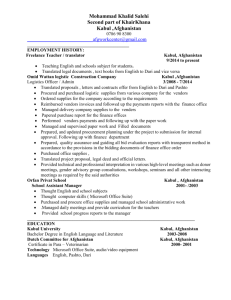

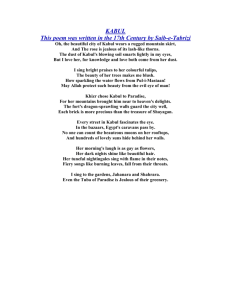
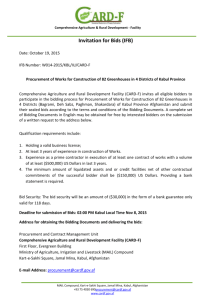
![Winter in Kabul [Fair translation, MC]](http://s2.studylib.net/store/data/013082354_1-e14e5a911bc2300954d7558910e2ac5e-300x300.png)
